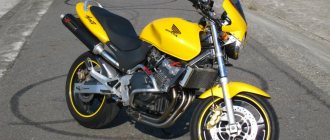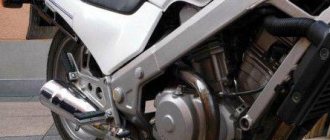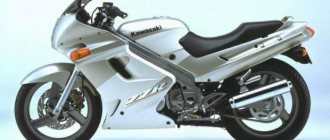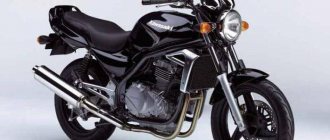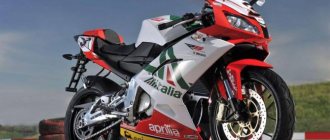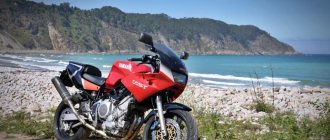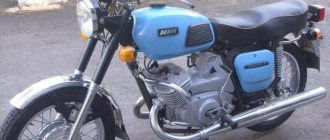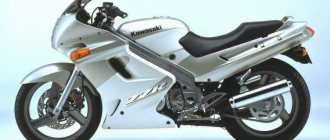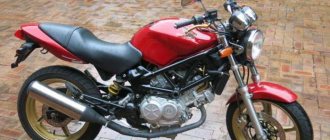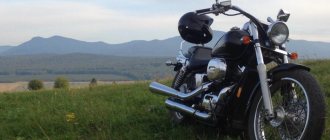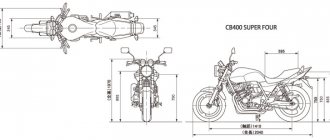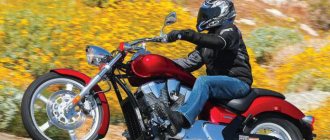- motorcycle model, Honda brand,
The Honda CBF 1000 road motorcycle model was first introduced in 2006 primarily for the European market. The model was based on a retuned engine from the sports Honda CBR1000RR and a frame from the Honda CBF 600. Unlike the sports “donor”, the Honda CBF 1000 engine was less explosive and had significantly less power, but torque was available at low speeds.
The Honda CBF 1000 engine is a liquid-cooled inline-four with a capacity of 998 cc. see and producing 97 hp. (108 hp - for the new generation) power and 93 Nm (96 Nm - for the new generation) torque, fully available at 6500 rpm.
The standard version of the motorcycle was produced with a semi-fairing (window height adjustable), an adjustable seat and a combined braking system with ABS (C-ABS), but there were other modifications.
Modifications
The manufacturer produced two versions of the road motorcycle:
- The first generation, Honda CBF 1000, was produced from 2006 to 2009. The version was equipped with a 98-horsepower engine, a steel frame, a 19-liter fuel tank and an analogue instrument panel.
- The second generation, produced since 2010, is the Honda CBF 1000F. The motorcycle received an aluminum frame, a 106 horsepower engine, a 20-liter fuel tank, a digital instrument panel, more advanced suspension with front fork preload adjustment and HMAS rear shock absorber rebound adjustment, and a 4-in-2 exhaust system. The model is still produced and offered by official dealers in European markets.
The classic modification of the Honda CBF 1000 with round optics and without a plastic body kit was created on the basis of the steel frame of its younger classmate - the CBF 600.
The second generation went on sale in 2010 after serious modifications. The steel frame was replaced by a light alloy one, a plastic fairing appeared, engine settings changed, the volume of the fuel tank increased and fuel consumption decreased. The second generation Honda CBF 100, unlike the first generation models, received a digital rather than analog instrument panel and became significantly lighter due to the reduction in frame weight.
The second generation CBF 1000F, equipped with a plastic body kit, is most often classified as sports touring motorcycles. Despite the fact that such a classification is very doubtful, many motorcyclists and experts in reviews of the Honda CBF 1000 still admit that the Japanese bike is ideal for the title of road motorcycle. It has good autonomy thanks to low fuel consumption and a decent gas tank volume, while excellent wind protection, a comfortable classic seating position and the ability to transport large loads allow it to cover long distances. The naked version of the CBF 1000N is much less suitable for the role of a touring motorcycle due to the lack of wind protection as such.
model history
2006 - start of production and sales of Honda CBF1000. Model: Honda CBF1000 (Europe). Frame number: ZDCSC58A06F6F000001 - ZDCSC58A06F6F049999. Model code: CBF10006, CBF1000A6.
2007 - no significant changes. The appearance of the touring modification GT. Model: Honda CBF1000 (Europe). Frame number: ZDCSC58B07F7F050001 - ZDCSC58B07F7F099999, ZDCSC58B07F7F100001 - ZDCSC58B07F7F199999. Model code: CBF10007, CBF1000A7, CBF1000S7, CBF1000T7.
2008 - no significant changes. Model: Honda CBF1000 (Europe). Frame number: ZDCSC58B08F8F300001 - ZDCSC58B08F8F399999. Model code: CBF10008, CBF1000A8, CBF1000S8, CBF1000T8.
2009 - no significant changes. Model: Honda CBF1000 (Europe). Frame number: ZDCSC58B0AFAF410001 - ZDCSC58B0AFAF999999. Model code: CBF1000A, CBF1000Aa, CBF1000SA, CBF1000TA.
2010+ - second generation. The letter F is added to the model name - Honda CBF1000F. The model gets a new front half-fairing design, different engine tuning, digital instrument panel, 4-into-2 exhaust system, 20L fuel tank and new adjustable suspensions. Model: Honda CBF1000F (Europe)..
Engine and technical specifications of Honda CBF 1000
The motorcycle engine was built on the basis of a 1-liter inline four-cylinder power unit with a liquid cooling system, borrowed from the Honda CBR 1000RR. The sports engine has been retuned and derated to increase traction and shift the optimal speed to the lower range. The task set by Honda engineers was achieved: engine power increased significantly - in the first generation it was 97 horsepower with a peak torque of 93 Nm, in the second - 108 horsepower with a torque of 96 Nm. Maximum power is gained at around 8-9 thousand revolutions. Smooth running is achieved by increasing traction at lower speeds. The acceleration dynamics is 3.8 seconds, the maximum speed is 230 km/h according to the data declared by the manufacturer.
The technical characteristics of the Honda CBF 1000 allow it to be considered one of the most powerful motorcycles in its class. The engine of the bike, in comparison with the sports version, was derated, but retained good power.
Minuses
- fork too soft
- high price
Comparison with analogues and competitors
The strong point of the CBF was the engine. In 2008, during a comparison test conducted with the Suzuki Bandit, the CBF won again, losing to the Yamahą FZ1 Fazer. The result was a foregone conclusion, because Yamaha had a heavier engine of 52 hp. and was highly rated due to performance. An opponent with a strength of 98 km had no chance. In turn, in the test, the best motorcycle for traveling on ordinary city roads, the CBF, won.
Repair Honda CBF 1000
Even the best motorcycle stops being attractive when it breaks down. But the CBF 1000 is no hassle. There are no major mechanical or electrical failures recorded, and the biggest problem with the motorcycle can only be cracks in the places where the deflectors are mounted. The lacquer finish on the rear frame could have been a little more durable. Especially in those places where stones fall from under the wheels. Chips turn into pockets of corrosion that need to be repaired.
Technical characteristics of Honda CBF 1000
The engine of the Honda CBF 1000 motorcycle can successfully serve in peaceful, everyday driving. And it brings a lot of pleasure.
- Four-stroke engine, water-cooled, displacement: 998 cc. cm.
- Compression ratio: 11.0:1
- Maximum torque: 93 Nm at 6500 rpm
- Maximum power: 72 kW (98 HP) at 8000 rpm.
- Gearbox: six-speed.
- Open steel frame.
- Front suspension - telescopic, 41 mm, travel 120 mm.
- Independent rear wheel suspension.
- Front brake: double disc, 296 mm, rear disc brake, 240 mm.
- Tires front/rear: 120/70 ZR 17 / 160/60 ZR 17
Options
- Length: 2156 mm
- Width: 782 mm
- Height: 1238 mm
- Seat height: 780-810 mm
- Wheelbase: 1483 mm
- Weight without liquid: 220 kg (with ABS 222 kg)
- Vehicle weight ready to drive: 252 kg (with ABS 254 kg)
- Permissible total weight with accessories: 445 kg
- Fuel tank capacity: 19.3 l
Performance
- Maximum speed: 228 km/h
- Average fuel consumption: 5.7 l/100 km
- Acceleration: 0-100 km/h 3.7 s; 0-200 km/h 15.8 s; 60-140 km/h 7.7 sec
Suspension
The Honda CBF 1000 is equipped with fairly rigid short-travel suspensions that are adjustable over a wide range of settings. The front telescopic fork is adjustable for preload and the rear monoshock is adjustable for both preload and rebound, allowing the owner to adjust the motorcycle to suit his individual riding style. The braking system is effective, corresponds to the dynamics of acceleration and is complemented by ABS.
The main advantage of the bike is its versatility: it is an ideal motorcycle option for a beginner. The classic and large CBF 1000 behaves confidently on the highway, where it can accelerate to 200 km/h without any problems, and in dense city traffic, where maneuvering among cars is required. Roomy trunks allow you to go on a long journey with a lot of luggage, but it is advisable to take the route along asphalt roads. Without refueling, a motorcycle for a beginner can cover about 350 kilometers.
The classic road motorcycle Honda CBF 1000 arrived in motorcycle showrooms in 2006. There are two versions of the bike - CBF1000 N, a classic modification without a plastic body kit and with a round headlight, and CBF1000 GT, also known as CBF 1000N, which has a developed plastic tail and is sometimes classified as a sports touring class, to which it, however, in no way belongs . The first generation of this motorcycle was built on a steel frame from its younger brother - the CBF 600.
In 2010, the second generation entered the series and underwent major modernization. The steel frame was replaced with a light alloy one, a full plastic fairing, different engine settings, which became more powerful, lower fuel consumption, a gas tank increased from 19 to 20 liters and a different exhaust system. The instrument panel has also become digital (the first generation had analog instruments), and the motorcycle itself has lost a little weight due to a lighter frame.
It is the plastic version of the Honda CBF 1000 F that is sometimes classified as a sports touring motorcycle. Despite the dubiousness of this classification, one cannot help but admit that this bike is excellent for long trips and can easily lay claim to the title of road touring bike. Excellent wind protection, a comfortable classic fit, a decent-sized gas tank and the ability to take all the necessary luggage with you make it perfectly suited to covering long distances. The naked version of the CBF 1000 N, due to the complete lack of wind protection as such, is much less suitable for the role of a touring bike.
The engine of this motorcycle was based on a liquid-cooled liter in-line four from
the Honda CBR 1000RR .
The sports engine has been derated and retuned to achieve greater traction and shift the optimal speed to the lower range. The idea was a great success; the Honda CBF 1000 has plenty of power (97 hp and 93 Nm on the first generation and 108 hp and 96 Nm on the second), with peak power at mid-range speeds - 8-9 thousand. The CBF 1000 also has a noticeable increase in low-end traction compared to its sports donor, which makes the ride smoother. The maximum speed of the motorcycle is 230 km/h, and acceleration from 0-100 km/h takes 3.8 seconds, according to the manufacturer, which is comparable to its main rivals - the Yamaha FZ-1S and Suzuki GSF 1250. The Honda CBF 1000 has enough suspension They are short-stroke and may seem harsh to some (120 mm of free play both front and rear), but they have a full range of adjustments. The telescopic fork is adjustable for preload, and the rear monoshock is adjustable for both preload and rebound, which allows you to customize the chassis to suit your riding style. The braking system matches the dynamics, in addition, as an additional option, Honda offers a version of this motorcycle with ABS. The brakes, by the way, are combined. The main advantage of this motorcycle is its versatility, if we talk about the Honda CBF 1000 F version. A large and comfortable classic road bike feels confident both on the highway, where it can easily accelerate to speeds well over 200 km/h, and in the city, where he can move calmly and gracefully between rows of cars. Having installed panniers on it, you can safely go on a long journey, the main thing is that the route must pass along roads with a normal asphalt surface, and besides, the CBF 1000 can cover up to 350 kilometers on one tank. Well, you can even create legends about the reliability of this motorcycle.
Transmission and dimensions
The Honda CBF 1000 has a chain drive, which increases engine efficiency due to the absence of power losses inherent in the cardan. A six-speed transmission with a hydraulic clutch is the best option for a bike of this class.
The wheelbase of the motorcycle is 1480 millimeters, the height of the saddle is 795 millimeters. Body length - 2210 mm, width - 780 mm, height - 1220 mm. The curb weight with a full fuel tank is 242 kilograms. Average fuel consumption is five liters per 100 kilometers.
Dimensions and weight
The height of the motorcycle at the saddle is 795 mm, and the wheelbase is 1480 mm. The model reaches 2210 mm in length, 780 mm in width, and 1220 mm in height. The bike weighs 242 kg including fuel, and its tank volume is as much as 20 liters. Considering the approximate average consumption of 5 liters per hundred, this is a completely acceptable capacity.
Brake system and chassis
The frame of the Honda CBF 1000 is entirely aluminum, which adds an impressive design to the motorcycle and emphasizes its belonging to a specific class. Smooth body lines enhance the aerodynamic characteristics of the motorcycle. The wheels are alloy, the steering wheel has classic dimensions.
The rear suspension is represented by a pendulum mechanism with a monoshock absorber, the front suspension is represented by a telescopic fork with a stroke of 41 millimeters. A 240 mm disc brake mechanism with a single-piston caliper is installed at the rear, and a 296 mm double-disc mechanism with four-piston calipers is installed at the front. An ABS system is offered as an additional option.
Main competitors and classmates
The first model of the Honda CBF 1000 motorcycle was released in 2006. The bike has been produced for over the past ten years, which is a kind of confirmation of its reliability.
Among the main competitors of the CBF 1000 are other Japanese motorcycles - Sudzuki GSF 1250 Bandit and Yamaha FZ-1. Both bikes are very interesting models that provide excellent competition to Honda’s brainchild.
Bike features
Here are the main features of this bike:
- versatility;
- very stylish, even by modern standards, design;
- good engine performance.
This car performs well both on a spacious country highway and on a small town street. What it is definitely not suitable for is off-road, but here, in fairness, it should be noted that only a few classes of bikes are theoretically designed for off-road, and theory does not always go hand in hand with practice.
Advantages of a motorcycle
The model, produced for more than ten years, has not undergone any changes. In 2010, the second generation CBF 1000 was introduced, which has the following advantages:
- Smooth and even engine power delivery.
- Excellent acceleration dynamics.
- Confident and smooth traction throughout the entire rev range.
- Soft and reliable suspension.
- Large fuel tank.
- Versions equipped with a windshield have excellent wind protection.
Reviews of Honda CBF 1000
Owners of the Japanese motorcycle note its wear resistance, but some parts still fail - sprockets, chains, pads, discs and tires, which is very typical for powerful bikes.
The working life of the chain during normal operation is 20 thousand kilometers and depends entirely on the regularity and thoroughness of maintenance. Pads are changed every 20-30 thousand kilometers, rubber - depending on its quality and softness.
The engine service life, provided that high-quality motor oil is used, exceeds 100 thousand kilometers. Owners of the Honda CBF 1000 note that a mileage of 15 thousand kilometers over three seasons is not typical for this motorcycle, since the bike was created for long trips and everyday use.
Fortunately, the motorcycle does not suffer from factory problems - it is enough to carry out regular maintenance and change consumables. The model also has ample opportunities for tuning. The manufacturer produces a line of accessories and original spare parts, which greatly facilitates the maintenance and repair of the motorcycle.
The minimum cost of a Honda CBF 1000 with mileage in Russia is 300 thousand rubles. Considering that the second generation of the bike is still in production, you can purchase a completely new model from official Honda dealers at an affordable price and without mileage in the Russian Federation.
The universal Japanese motorcycle Honda CBF 1000 is one of the best road bikes, suitable for daily use by both professional motorcycle enthusiasts and beginners.
Test drive of the Honda CBF 1000 motorcycle from the magazine Za Rulyom
The new Honda CBF 1000 acquired an aluminum frame in 2010, an engine from the first “liter” Fireblade of 2004, and a new body kit. In fact, this is a completely new motorcycle with the same name and the same target audience. The new “cibieff” has finally distanced itself from the more “evil” and deliberately aggressive Honda CB1000R , tightly occupying the niche of a “calm motorcycle for every day”, with the possibility of upgrading to a “tourist”. The motik leaves a strange impression. Firstly, it is very compact and subjectively light. The classic relaxed seating position with a subtle forward lean also plays into this. The narrow steering wheel is very reminiscent of the “great-grandmother’s” one - from the Honda CB400SF , and the controls, right down to the steering wheel grips, levers and even the rubber on the gearbox “foot” are absolutely the same. It seems like more than twenty years have passed! However, it is absolutely impossible to find fault with these familiar and even somewhere familiar Honda buttons and levers.
During the first test day I covered about two hundred kilometers, and the first impressions were, to put it mildly, mixed. On the one hand, the motorcycle seemed like an “old acquaintance.” And the main reason for this is not so much the same familiar controls as the absolute obedience and predictability of the motorcycle. He turned out to be so friendly to the user that a common language was found with him instantly and in full. On the other hand, all of the above led to the conclusion: CBF completely lacks strong character traits. There is no zest in him that would make his face. True, it does not have any obvious (or smaller) shortcomings. “Sibief” is simply a very good, just a motorcycle for just riding. Dot. The same definition is true for the motor. The engine from Fireblade, almost doubled (from 172 to 98 hp), does its job so smoothly and evenly that I was unable to find any pickup or even just feel the usual “liter” acceleration. It’s a shame I even started to think: weren’t the manufacturers lying about the power? I remember the exercises on the “four hundred”: it seems to be going, and you even seem to feel some kind of “traction”, especially against the backdrop of the “sovietcycles”, but as soon as you try something more, the “coffee grinder” fades, forever taking its rightful place in at the end of the list of “cool bikes”. Apparently, I haven’t driven a 400 for a long time and have driven too many adult liters – the sensations have dulled. Fortunately, that same evening I was asked to drive the “four hundredth seabird.” After the trip, the picture of the world returned to normal, and I believed that CBF was really a “liter”, although very calm and balanced. While driving the CBF, I tried to build a power graph curve in my head: the result was not a “curve”, but a “straight” one. All horsepower is “spread” over the revolutions in such an even and thick layer, as if the engine is not gasoline, but electric. Subsequently, measurements on a dynamometer confirmed my guesses: the torque curve turned out to be almost a regular arc with a maximum approximately in the middle of the rev range, and the power graph turned out to be drawn as if drawn on a ruler. Approximately the same epithets can be used to describe the operation of a combined braking system with ABS. No complaints or delights. Perhaps the lever with the traditional Honda soft and long stroke may seem too “wobbly” to some, but you quickly get used to it, and “hondophiles” will unanimously say that this is how it should be.
If someone needs to impress others and himself by setting speed records, scraping his knees on the asphalt and showing off in front of beauties and in shop windows in front of himself, then CBF is definitely not for him. It is for those for whom it is more important to feel the inner comfort of complete control over themselves and equipment, for whom unity with the machine is more important and who simply value comfort in the most everyday sense of the word. “Sibief” is truly the most comfortable of the entire trio, not only in terms of ergonomics, but in terms of the totality of all characteristics: ease of control, comfort, reactions to the pilot’s commands... This is the unanimous opinion of the entire test group.
But don’t think that CBF is a retirement rocking chair. A rigid frame and a “combed” engine from the company’s flagship, albeit from the past, this is not a bike with a motor! It can do everything - from performing confident wheelies and stoppies (in the version without ABS, of course) to serious grips with sawing sliders and pegs anchors on the asphalt. The suspensions do not boast a full range of adjustments, limited to simple compression of the shock absorber spring, but they do their job in harmony with the entire device, that is, “you can’t complain.” If you correctly grasp the mood of the motorcycle, that is, enjoy a calm but dynamic ride, there is really nothing to complain about. In short, the motorcycle “can” do absolutely everything that a modern bike is supposed to do, but it does it very calmly and smoothly.
Honda CBF 1000 is the golden mean in our test. Not too eager and not too heavy. I personally gave this motorcycle first place. I really liked feeling like I was in complete “raspberry”, while maintaining a feeling of absolute control and the ability, if necessary, to “give the country coal,” albeit without the release of “positive adrenaline” that other “liters” are able to generate.
Source: Behind the wheel
Go to the Honda CBF 1000
Check out the test drives:
- Test drive of the 2010 Honda CBF 1000 motorcycle
- Test drive of the Honda CBF 1000 motorcycle from Motorreview magazine
Review of the Honda CBF 1000 motorcycle
- Read review of Honda CBF 1000
